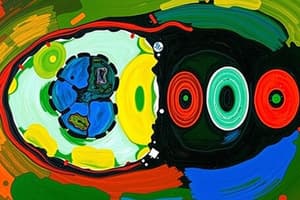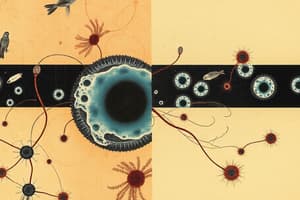Podcast
Questions and Answers
Which structure is primarily responsible for producing insulin?
Which structure is primarily responsible for producing insulin?
- Pancreas (correct)
- Liver
- Heart
- Kidneys
Glucagon decreases blood sugar levels.
Glucagon decreases blood sugar levels.
False (B)
What are the two hormones that regulate blood glucose levels?
What are the two hormones that regulate blood glucose levels?
Insulin and glucagon
The cells that detect stimuli and convert them into electrical impulses are called __________.
The cells that detect stimuli and convert them into electrical impulses are called __________.
Match the hormone with its effect on blood sugar:
Match the hormone with its effect on blood sugar:
What is the function of hormones in the endocrine system?
What is the function of hormones in the endocrine system?
Target tissues are organs that respond to all hormones.
Target tissues are organs that respond to all hormones.
What is glycogen and where is it primarily stored?
What is glycogen and where is it primarily stored?
The __________ are a group of organs that produce hormones.
The __________ are a group of organs that produce hormones.
What is the primary function of the capillary network associated with villi in the small intestine?
What is the primary function of the capillary network associated with villi in the small intestine?
The lacteal is responsible for absorbing amino acids from the small intestine.
The lacteal is responsible for absorbing amino acids from the small intestine.
What is the name of the chamber of the heart that receives oxygenated blood from the lungs?
What is the name of the chamber of the heart that receives oxygenated blood from the lungs?
The small intestine features structures called ______ that enhance nutrient absorption.
The small intestine features structures called ______ that enhance nutrient absorption.
Match the following blood vessels with their descriptions:
Match the following blood vessels with their descriptions:
Which type of molecule is primarily absorbed by the lacteals in the small intestine?
Which type of molecule is primarily absorbed by the lacteals in the small intestine?
Veins have valves that prevent backflow of blood.
Veins have valves that prevent backflow of blood.
Name one feature of alveoli that improves the efficiency of gas exchange.
Name one feature of alveoli that improves the efficiency of gas exchange.
What is one primary function of capillary networks in tissues?
What is one primary function of capillary networks in tissues?
A large surface area decreases the efficiency of absorption.
A large surface area decreases the efficiency of absorption.
List two features that make a surface good at absorption.
List two features that make a surface good at absorption.
Alveoli are surrounded by many __________ to assist in gas exchange.
Alveoli are surrounded by many __________ to assist in gas exchange.
Match the following components with their functions:
Match the following components with their functions:
Which of the following is a waste product from respiration that is removed from the bloodstream?
Which of the following is a waste product from respiration that is removed from the bloodstream?
The walls of the small intestine have a low surface area.
The walls of the small intestine have a low surface area.
What role do alveoli play in the lungs?
What role do alveoli play in the lungs?
The acronym BLT stands for __________, __________, and __________.
The acronym BLT stands for __________, __________, and __________.
Flashcards
Receptor cells
Receptor cells
Cells that detect a stimulus and convert it into an electrical impulse.
Effectors
Effectors
Parts of the body (muscles or glands) that respond to the signal from the brain or nervous system.
Hormones
Hormones
Chemical messengers that travel in the bloodstream to target tissues.
Endocrine glands
Endocrine glands
Signup and view all the flashcards
Target tissue
Target tissue
Signup and view all the flashcards
Insulin
Insulin
Signup and view all the flashcards
Glucagon
Glucagon
Signup and view all the flashcards
Glucose
Glucose
Signup and view all the flashcards
Good absorption surface features
Good absorption surface features
Signup and view all the flashcards
Capillary networks
Capillary networks
Signup and view all the flashcards
Alveoli
Alveoli
Signup and view all the flashcards
Gas exchange in alveoli
Gas exchange in alveoli
Signup and view all the flashcards
Villi in small intestine
Villi in small intestine
Signup and view all the flashcards
Small intestine absorption
Small intestine absorption
Signup and view all the flashcards
Villi function
Villi function
Signup and view all the flashcards
Carbon Dioxide Removal
Carbon Dioxide Removal
Signup and view all the flashcards
Lacteal
Lacteal
Signup and view all the flashcards
Villi
Villi
Signup and view all the flashcards
What is absorbed by capillaries?
What is absorbed by capillaries?
Signup and view all the flashcards
What is absorbed by lacteals?
What is absorbed by lacteals?
Signup and view all the flashcards
What is the function of villi?
What is the function of villi?
Signup and view all the flashcards
Why are villi efficient at absorption?
Why are villi efficient at absorption?
Signup and view all the flashcards
How do villi and capillaries work together?
How do villi and capillaries work together?
Signup and view all the flashcards
Study Notes
National 5 Biology Unit 2: Multicellular Organisms
-
Topic 2.1: Producing New Cells
- Mitosis is the process of a diploid cell dividing.
- Chromatids are the two identical copies of a chromosome.
- The equator is the imaginary line down the middle of the cell.
- Spindle fibres pull the chromatids apart during mitosis and move them to opposite poles of the cell.
- Diploid cells have two sets of matching chromosomes.
- Chromosomes are made of tightly coiled DNA.
- Stem cells are unspecialized cells that can differentiate into different cell types.
- Stem cells are important for growth and repair.
- Stem cells are found in embryos and in the body of adults (e.g., bone marrow).
- A multicellular organism is made up of more than one cell type.
- Cells specialize to carry out particular functions.
- Cells, tissues, organs, and organ systems are used to organize the human body.
-
Topic 2.2: Plant Transport Systems
- Plant organs include roots, stems, and leaves.
- Key leaf tissues: upper epidermis, palisade mesophyll, spongy mesophyll, lower epidermis, stomata, guard cells, and veins (containing xylem and phloem).
- Water transport: root hairs absorb water, moving upward through the xylem to the leaves.
- Xylem vessels are tube-like structures that transport water and minerals. Lignin strengthens xylem to withstand pressure changes.
- Transpiration is the process of water moving up the plant and evaporating from the stomata.
- Factors affecting transpiration rate: wind speed, temperature, surface area, and humidity.
- Apparatus for measuring transpiration rate: potometer.
-
Topic 2.3: Reproduction (animals & plants)
- Gametes are haploid (single set of chromosomes).
- Sperm are male gametes, produced in the testes.
- Eggs are female gametes, produced in the ovaries.
- Pollen is the male gamete in plants, produced in the anthers.
- Ovules are the female gamete in plants, produced in the ovary.
- Fertilization is the fusion of the nuclei of two haploid gametes, producing a diploid zygote.
- The zygote divides to form an embryo.
-
Topic 2.4: Variation and Inheritance
- Variation is the difference between members of a species.
- Discrete variation has distinct groups.
- Continuous variation has a wide range of values.
- Polygenic inheritance affects traits like height or skin colour
- Genes are sections of DNA that code for proteins.
- Alleles are different forms of a gene.
- Phenotype is an organism's observable characteristics.
- Genotype is the combination of alleles an organism possesses.
- Dominant alleles determine the trait even when only one copy is present.
- Recessive alleles are only expressed when both copies are present.
- Homozygous means possessing two identical alleles (e.g., BB or bb).
- Heterozygous means possessing two different alleles (e.g., Bb).
- Monohybrid crosses using Punnett squares predict offspring genotypes.
-
Topic 2.5: Control and Communication
- The nervous system has three parts: central nervous system, sensory neurons, motor neurons.
- Receptors detect stimuli and produce electrical signals.
- Neurons rapidly transmit messages.
- Synapses are gaps between neurons, passing signals via chemicals (neurotransmitters).
- Reflexes are automatic responses to stimuli, helping to protect the body.
- The endocrine system releases hormones into the bloodstream.
- Hormones regulate specific target tissues.
- Examples of hormones in blood glucose regulation; insulin, glucagon, glycogen.
-
Topic 2.6: Animal Transport Systems
- The circulatory system transports substances throughout the body, composed of the heart, blood vessels, and blood.
- Arteries carry blood away from the heart.
- Veins carry blood towards the heart.
- Capillaries are thin-walled vessels where exchange between blood and body cells takes place.
- The heart has four chambers: two atria (receiving chambers) and two ventricles (pumping chambers).
- Blood is composed of plasma, red blood cells (carrying oxygen), white blood cells (defending against pathogens), and platelets (involved in clotting).
- Red blood cells have a biconcave shape for maximum surface area and contain haemoglobin to carry oxygen.
Studying That Suits You
Use AI to generate personalized quizzes and flashcards to suit your learning preferences.




